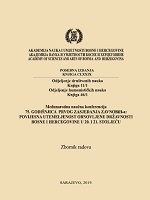THE GREAT SERBIAN THREAT, ZAVNOBIH AND MUSLIM BOSNIAK ENTRY INTO THE PEOPLE’S LIBERATION MOVEMENT
THE GREAT SERBIAN THREAT, ZAVNOBIH AND MUSLIM BOSNIAK ENTRY INTO THE PEOPLE’S LIBERATION MOVEMENT
Author(s): Marko Attila Hoare
Subject(s): Ethnohistory, Political history, Islam studies, WW II and following years (1940 - 1949), Fascism, Nazism and WW II, Wars in Jugoslavia
Published by: Akademija Nauka i Umjetnosti Bosne i Hercegovine
Keywords: revolution; fascism; anti-fascism; resistance; cooperation;
Summary/Abstract: From the start of the uprising in summer 1941, the Communist Party of Yugoslavia conceived of the People’s Liberation Struggle in Bosnia-Herzegovina as a specifically Bosnian-Herzegovinian liberation struggle, waged under Bosnian-patriotic slogans. Nevertheless, the status of Bosnia-Herzegovina within the future Yugoslav state was not definitely resolved until November 1943. This period – autumn 1943 – witnessed the mass influx of Muslim Bosniaks into the People’s Liberation Movement, definitely transforming it from a movement that was overwhelmingly ethnic-Serb in composition into one that had a large Muslim Bosniak component as well. A decisive catalyst for the mass entry of Muslim Bosniaks in East Bosnia into the NOP was the fear among them that Hitler would cede East Bosnia to Nedić’s Serbia, thereby establishing a Great Serbia in which the Muslim Bosniaks would be subjected to genocide. The KPJ, by championing Bosnian-Herzegovinian self-determination, was able to win over a large part of the Muslim Bosniak population that feared the Great Serbian threat. This paper will look at the relationship between the Great Serbian threat and the influx of Muslim Bosniaks into the NOP during 1943.
- Page Range: 115-130
- Page Count: 16
- Publication Year: 2019
- Language: English
- Content File-PDF

